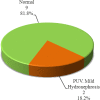Incidence of urinary tract infection in neonates with significant indirect Hyperbilirubinemia of unknown etiology: case-control study
- PMID: 33596989
- PMCID: PMC7891145
- DOI: 10.1186/s13052-021-00982-0
Incidence of urinary tract infection in neonates with significant indirect Hyperbilirubinemia of unknown etiology: case-control study
Abstract
Background: Indirect hyperbilirubinemia is frequently encountered during neonatal period. Although it has different causes, in some cases it can't be explained. Previous studies have illustrated that jaundice could be a major sign of urinary tract infection (UTI) in neonates.
Aim of the work: We aimed to determine the association between UTI and significant unexplained neonatal indirect hyperbilirubinemia.
Methods: This prospective controlled study was performed on 150 neonates divided in two groups (100 as cases and 50 as controls) to investigate the incidence of UTI in neonates with significant unexplained hyperbilirubinemia. Urine sample was obtained using urine catheterization technique from neonates and full urine analysis was done and cases with pyuria had urine culture to confirm UTI. Immediate renal ultrasonography (USG) was performed for neonates with UTI.
Results: UTI incidence was 11% in cases while none of neonates in control group had UTI with statistical significance between cases and controls (P value < 0.05). The most common (36.4%) pathogen was Escherichia coli. Posterior urethral valve with mild hydronephrosis was diagnosed in 18.2% of UTI positive patients by renal ultrasonography.
Conclusion: In neonates with unexplained indirect hyperbilirubinemia, UTI should be considered as a pathological cause.
Keywords: Hyperbilirubinemia; Incidence; Neonates; Urinary tract infection.
Conflict of interest statement
The authors declare that they have no competing interests.
Figures


References
-
- Pashapour N, Nikibahksh AA, Golmohammadlou S. Urinary tract infection in term neonates with prolonged jaundice. Urol J. 2007;4:91–94. - PubMed
-
- Bilgen H, Ozek E, Unver T, Biyikli N, Alpay H, Cebeci D. Urinary tract infection and hyperbilirubinemia. Turk J Pediatr. 2006;48:51–55. - PubMed
-
- Zafarzadeh M, Mohammadzadeh A. Should urine culture be considered in the hyperbilirubinemia work up of neonate? J Chinese Clin Med. 2009;4(3):136–138.
Publication types
MeSH terms
LinkOut - more resources
Full Text Sources
Other Literature Sources
Medical
Research Materials

